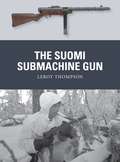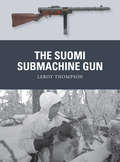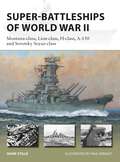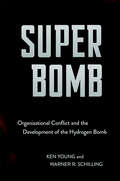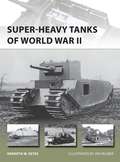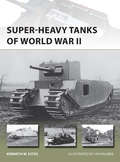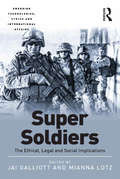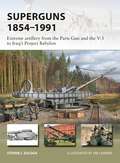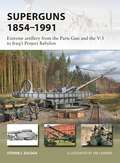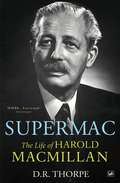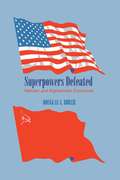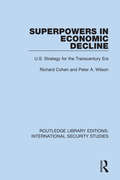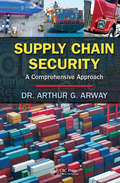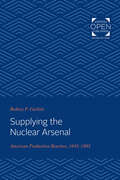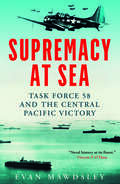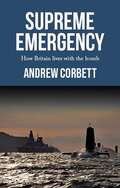- Table View
- List View
The Suomi Submachine Gun (Weapon)
by Adam Hook Leroy Thompson Alan GillilandEntering service in 1931, the 9x19mm Suomi KP/-31 submachine gun saw extensive combat with Finnish troops during their fight against Soviet forces in 1939–44. It was also manufactured under licence in Switzerland, Denmark and Sweden, and remained in Finnish service until the 1980s, an indication of its durability.Rugged and accurate, the Suomi was a favourite with Finnish ski troops who would strike from ambush, cutting down Soviet troops, then skiing away into the woods. Initially used by the Finns as a light machine gun at infantry squad level, it eventually became a dedicated submachine gun, and since it had been designed to be more accurate than the typical SMG, it was often even used as a sniping weapon, or to supplement longer-ranged rifles such as the Mosin-Nagant. Featuring first-hand accounts and specially commissioned colour artwork, this is the story of one of World War II's most distinctive and respected infantry weapons.
The Suomi Submachine Gun (Weapon #54)
by Adam Hook Leroy Thompson Alan GillilandEntering service in 1931, the 9x19mm Suomi KP/-31 submachine gun saw extensive combat with Finnish troops during their fight against Soviet forces in 1939–44. It was also manufactured under licence in Switzerland, Denmark and Sweden, and remained in Finnish service until the 1980s, an indication of its durability.Rugged and accurate, the Suomi was a favourite with Finnish ski troops who would strike from ambush, cutting down Soviet troops, then skiing away into the woods. Initially used by the Finns as a light machine gun at infantry squad level, it eventually became a dedicated submachine gun, and since it had been designed to be more accurate than the typical SMG, it was often even used as a sniping weapon, or to supplement longer-ranged rifles such as the Mosin-Nagant. Featuring first-hand accounts and specially commissioned colour artwork, this is the story of one of World War II's most distinctive and respected infantry weapons.
Super-Battleships of World War II: Montana-class, Lion-class, H-class, A-150 and Sovetsky Soyuz-class (New Vanguard)
by Mark StilleA study of the design, development and eventual fates of the uncompleted super-battleships intended to be built before and during World War II. At the start of World War II the battleship was still king, and all the major powers were designing even mightier battleships to surpass their most modern and powerful classes. But when World War II broke out, aircraft carriers would dominate naval warfare, and none of these monster warships were completed.In this book, naval expert Mark Stille uncovers these lost battleships as they are reconstructed with superb new full-colour artwork. The US Navy wanted five Montana-class ships, based on the Iowas but with a heavier main battery and improved protection, and the Royal Navy began work on three 16in-gun Lion-class fast battleships. The German Navy developed its H-class designs: initially an improved Bismack-class, they became more fantastical, culminating in the 141,500-ton, 20in-gun H-44. The Japanese A-150 was based on the Yamato-class but with 20.1in guns, while the 15 ships planned for the USSR's Sovetsky Soyuz-class would have rivalled the Montanas in size. Explaining the design, intended roles and fate of these ships, this is the story of the last battleship designs in history.
Super-Battleships of World War II: Montana-class, Lion-class, H-class, A-150 and Sovetsky Soyuz-class (New Vanguard)
by Mark StilleA study of the design, development and eventual fates of the uncompleted super-battleships intended to be built before and during World War II. At the start of World War II the battleship was still king, and all the major powers were designing even mightier battleships to surpass their most modern and powerful classes. But when World War II broke out, aircraft carriers would dominate naval warfare, and none of these monster warships were completed.In this book, naval expert Mark Stille uncovers these lost battleships as they are reconstructed with superb new full-colour artwork. The US Navy wanted five Montana-class ships, based on the Iowas but with a heavier main battery and improved protection, and the Royal Navy began work on three 16in-gun Lion-class fast battleships. The German Navy developed its H-class designs: initially an improved Bismack-class, they became more fantastical, culminating in the 141,500-ton, 20in-gun H-44. The Japanese A-150 was based on the Yamato-class but with 20.1in guns, while the 15 ships planned for the USSR's Sovetsky Soyuz-class would have rivalled the Montanas in size. Explaining the design, intended roles and fate of these ships, this is the story of the last battleship designs in history.
Super Bomb: Organizational Conflict and the Development of the Hydrogen Bomb (Cornell Studies in Security Affairs)
by Ken Young Warner R. SchillingSuper Bomb unveils the story of the events leading up to President Harry S. Truman's 1950 decision to develop a "super," or hydrogen, bomb. That fateful decision and its immediate consequences are detailed in a diverse and complete account built on newly released archives and previously hidden contemporaneous interviews with more than sixty political, military, and scientific figures who were involved in the decision. Ken Young and Warner R. Schilling present the expectations, hopes, and fears of the key individuals who lobbied for and against developing the H-bomb. They portray the conflicts that arose over the H-bomb as rooted in the distinct interests of the Atomic Energy Commission, the Los Alamos laboratory, the Pentagon and State Department, the Congress, and the White House. But as they clearly show, once Truman made his decision in 1950, resistance to the H-bomb opportunistically shifted to new debates about the development of tactical nuclear weapons, continental air defense, and other aspects of nuclear weapons policy. What Super Bomb reveals is that in many ways the H-bomb struggle was a proxy battle over the morality and effectiveness of strategic bombardment and the role and doctrine of the US Strategic Air Command.
Super-heavy Tanks of World War II (New Vanguard)
by Ian Palmer Kenneth W EstesThe super-heavy tanks of World War II are heirs to the siege machine tradition – a means of breaking the deadlock of ground combat. As a class of fighting vehicle, they began with the World War I concept of the search for a 'breakthrough' tank, designed to cross enemy lines. It is not surprising that the breakthrough tank projects of the period prior to World War II took place in the armies that suffered the most casualties of the Great War (Russia, France, Germany). All of the principal Axis and Allied nations eventually initiated super-heavy development projects, with increasingly heavy armor and armament. Much as the casualties of World War I prompted the original breakthrough tank developments, as Germany found itself on the defensive, with diminishing operational prospects and an increasingly desperate leadership, so too did its focus turn to the super-heavy tanks that could turn the tide back in their favor.
Super-heavy Tanks of World War II (New Vanguard #216)
by Ian Palmer Kenneth W EstesThe super-heavy tanks of World War II are heirs to the siege machine tradition – a means of breaking the deadlock of ground combat. As a class of fighting vehicle, they began with the World War I concept of the search for a 'breakthrough' tank, designed to cross enemy lines. It is not surprising that the breakthrough tank projects of the period prior to World War II took place in the armies that suffered the most casualties of the Great War (Russia, France, Germany). All of the principal Axis and Allied nations eventually initiated super-heavy development projects, with increasingly heavy armor and armament. Much as the casualties of World War I prompted the original breakthrough tank developments, as Germany found itself on the defensive, with diminishing operational prospects and an increasingly desperate leadership, so too did its focus turn to the super-heavy tanks that could turn the tide back in their favor.
Super Soldiers: The Ethical, Legal and Social Implications (Emerging Technologies, Ethics and International Affairs)
by Jai Galliott Mianna LotzThe Spartan City State produced what is probably one of the most iconic and ruthless military forces in recorded history. They believed that military training and education began at birth. Post-World War II saw a shift to army tanks, fighter jets and missiles that would go on to fight the next huge battle in Northern Europe. Today, with the advent of unmanned systems, our hopes are attached to the idea that we can fight our battles with soldiers pressing buttons in distant command centres. However, soldiers must now be highly trained, super strong and have the intelligence and mental capacity to handle the highly complex and dynamic military operating environment. It is only now as we progress into the twenty-first century that we are getting closer to realising the Spartan ideal and creating a soldier that can endure more than ever before. This book provides the first comprehensive and unifying analysis of the moral, legal and social questions concerning military human enhancement, with a view toward developing guidance and policy that may influence real-world decision making.
Super Soldiers: The Ethical, Legal and Social Implications (Emerging Technologies, Ethics and International Affairs)
by Jai Galliott Mianna LotzThe Spartan City State produced what is probably one of the most iconic and ruthless military forces in recorded history. They believed that military training and education began at birth. Post-World War II saw a shift to army tanks, fighter jets and missiles that would go on to fight the next huge battle in Northern Europe. Today, with the advent of unmanned systems, our hopes are attached to the idea that we can fight our battles with soldiers pressing buttons in distant command centres. However, soldiers must now be highly trained, super strong and have the intelligence and mental capacity to handle the highly complex and dynamic military operating environment. It is only now as we progress into the twenty-first century that we are getting closer to realising the Spartan ideal and creating a soldier that can endure more than ever before. This book provides the first comprehensive and unifying analysis of the moral, legal and social questions concerning military human enhancement, with a view toward developing guidance and policy that may influence real-world decision making.
Superguns 1854–1991: Extreme artillery from the Paris Gun and the V-3 to Iraq's Project Babylon (New Vanguard)
by Steven J. ZalogaOver the last 150 years, gun designers have sought to transform warfare with artillery of superlative range and power, from William Armstrong's 19th-century “monster guns” to the latest research into hypersonic electro-magnetic railguns.Taking a case study approach, Superguns explains the technology and role of the finest monster weapons of each era. It looks at the 1918 “Wilhelm Gun,” designed to shell Paris from behind the German trenches; the World War II “V-3” gun built to bombard London across the Channel; the Cold War atomic cannons of the US and Soviet Union; and the story of Dr Gerald Bull's HARP program and the Iraqi “Supergun” he designed for Saddam Hussein. Illustrated throughout, this is an authoritative history of the greatest and most ambitious artillery pieces of all time.
Superguns 1854–1991: Extreme artillery from the Paris Gun and the V-3 to Iraq's Project Babylon (New Vanguard #265)
by Steven J. Zaloga Jim LaurierOver the last 150 years, gun designers have sought to transform warfare with artillery of superlative range and power, from William Armstrong's 19th-century “monster guns” to the latest research into hypersonic electro-magnetic railguns.Taking a case study approach, Superguns explains the technology and role of the finest monster weapons of each era. It looks at the 1918 “Wilhelm Gun,” designed to shell Paris from behind the German trenches; the World War II “V-3” gun built to bombard London across the Channel; the Cold War atomic cannons of the US and Soviet Union; and the story of Dr Gerald Bull's HARP program and the Iraqi “Supergun” he designed for Saddam Hussein. Illustrated throughout, this is an authoritative history of the greatest and most ambitious artillery pieces of all time.
Supermac: The Life of Harold Macmillan
by Dr D R ThorpeGreat-grandson of a crofter and son-in-law of a Duke, Harold Macmillan (1894-1986) was both complex as a person and influential as a politican. Marked by terrible experiences in the trenches in the First World War and by his work as an MP during the Depression, he was a Tory rebel - an outspoken backbencher, opposing the economic policies of the 1930s and the appeasement policies of his own government.Churchill gave him responsibility during the Second World War with executive command as 'Viceroy of the Mediterranean'. After the War, in opposition, Macmillan was one of the principal reformers of the Conservatives, and after 1951, back in government, served in several important posts before becoming Prime Minister after the Suez Crisis.Supermac examines key events including the controversy over the Cossacks repatriation, the Suez Crisis, You've Never Had It So Good, the Winds of Change, the Cuban Missile Crisis and the Profumo Scandal. The culmination of thirty-five years of research into this period by one of our most respected historians, this book gives an unforgettable portrait of a turbulent age.Shortlisted for the Orwell Prize.
Supermarine Spitfire (large print)
by RnibThis page shows two images of an aircraft. At the top of the page seen from the side and in the bottom and middle of the page a plan view seen from above. There is a locator dot shown, which will be at the top left of the page when the image is the correct way up. Both views have the front on the left and the tail on the right of the page. The aircraft is shown in a flying position so the wheels are retracted and not shown. The aircraft in the top of the page has the propeller on the left with one blade pointing up and one pointing down. The nose cone is pale grey. Right from this is a rectangle which comprises six exhaust outlets. Down and right from the exhaust is the tip of the wing pointing towards you. The front edge on the left has a cannon sticking out. Up from the wing in the middle top of the fuselage is the cockpit cover shown as two windows. The centre of the fuselage has letters identifying which individual aircraft it is. There is also red and blue roundel indicating the plane belongs to the RAF. On the top edge of the fuselage there is an aerial sticking up. Right of this the fuselage continues to the vertical tail fin on the right. At base of the fin is the end of one of the tail wings. Right of this is a vertical flap. This is one of the ailerons used to manoeuvre the aircraft when it is flying. The tail has a red rectangle and a blue rectangle separated by a white line indicating the plane belongs to the RAF. In the plan view image in the bottom and middle of the page the fuselage goes from left to right in the centre of the image. The main wings go up and down the page from the fuselage. In the left of the page the propeller has one blade pointing up and one pointing down. The tip of the nose cone is pale grey. To the right of the propeller six exhaust outlets can be found on the top and bottom edge of the fuselage. Right of this are the wings. Each wing has two cannons mounted on the front edge. In the centre of each wing there is a red and blue roundel indicating the plane belongs to the RAF. On the right of each wing tip is a flap. These are two of the ailerons used to manoeuvre the aircraft when it is flying. In the centre of the fuselage between the wings is the cockpit shown as two windows. The fuselage continues to the right ending in the tailplane. On the right of each tail wing is a flap. These are two more of the ailerons used to manoeuvre the aircraft when it is flying.
Supermarine Spitfire (UEB contracted)
by RnibThis page shows two images of an aircraft. At the top of the page seen from the side and in the bottom and middle of the page a plan view seen from above. There is a locator dot shown, which will be at the top left of the page when the image is the correct way up. Both views have the front on the left and the tail on the right of the page. The aircraft is shown in a flying position so the wheels are retracted and not shown. The aircraft in the top of the page has the propeller on the left with one blade pointing up and one pointing down. The nose cone is pale grey. Right from this is a rectangle which comprises six exhaust outlets. Down and right from the exhaust is the tip of the wing pointing towards you. The front edge on the left has a cannon sticking out. Up from the wing in the middle top of the fuselage is the cockpit cover shown as two windows. The centre of the fuselage has letters identifying which individual aircraft it is. There is also red and blue roundel indicating the plane belongs to the RAF. On the top edge of the fuselage there is an aerial sticking up. Right of this the fuselage continues to the vertical tail fin on the right. At base of the fin is the end of one of the tail wings. Right of this is a vertical flap. This is one of the ailerons used to manoeuvre the aircraft when it is flying. The tail has a red rectangle and a blue rectangle separated by a white line indicating the plane belongs to the RAF. In the plan view image in the bottom and middle of the page the fuselage goes from left to right in the centre of the image. The main wings go up and down the page from the fuselage. In the left of the page the propeller has one blade pointing up and one pointing down. The tip of the nose cone is pale grey. To the right of the propeller six exhaust outlets can be found on the top and bottom edge of the fuselage. Right of this are the wings. Each wing has two cannons mounted on the front edge. In the centre of each wing there is a red and blue roundel indicating the plane belongs to the RAF. On the right of each wing tip is a flap. These are two of the ailerons used to manoeuvre the aircraft when it is flying. In the centre of the fuselage between the wings is the cockpit shown as two windows. The fuselage continues to the right ending in the tailplane. On the right of each tail wing is a flap. These are two more of the ailerons used to manoeuvre the aircraft when it is flying.
Supermarine Spitfire (UEB uncontracted)
by RnibThis page shows two images of an aircraft. At the top of the page seen from the side and in the bottom and middle of the page a plan view seen from above. There is a locator dot shown, which will be at the top left of the page when the image is the correct way up. Both views have the front on the left and the tail on the right of the page. The aircraft is shown in a flying position so the wheels are retracted and not shown. The aircraft in the top of the page has the propeller on the left with one blade pointing up and one pointing down. The nose cone is pale grey. Right from this is a rectangle which comprises six exhaust outlets. Down and right from the exhaust is the tip of the wing pointing towards you. The front edge on the left has a cannon sticking out. Up from the wing in the middle top of the fuselage is the cockpit cover shown as two windows. The centre of the fuselage has letters identifying which individual aircraft it is. There is also red and blue roundel indicating the plane belongs to the RAF. On the top edge of the fuselage there is an aerial sticking up. Right of this the fuselage continues to the vertical tail fin on the right. At base of the fin is the end of one of the tail wings. Right of this is a vertical flap. This is one of the ailerons used to manoeuvre the aircraft when it is flying. The tail has a red rectangle and a blue rectangle separated by a white line indicating the plane belongs to the RAF. In the plan view image in the bottom and middle of the page the fuselage goes from left to right in the centre of the image. The main wings go up and down the page from the fuselage. In the left of the page the propeller has one blade pointing up and one pointing down. The tip of the nose cone is pale grey. To the right of the propeller six exhaust outlets can be found on the top and bottom edge of the fuselage. Right of this are the wings. Each wing has two cannons mounted on the front edge. In the centre of each wing there is a red and blue roundel indicating the plane belongs to the RAF. On the right of each wing tip is a flap. These are two of the ailerons used to manoeuvre the aircraft when it is flying. In the centre of the fuselage between the wings is the cockpit shown as two windows. The fuselage continues to the right ending in the tailplane. On the right of each tail wing is a flap. These are two more of the ailerons used to manoeuvre the aircraft when it is flying.
Superpowers Defeated: Vietnam and Afghanistan Compared
by Douglas A. BorerDuring the Cold War, military conflicts in Vietnam and Afghanistan validated the importanct of war in global power dynamics. But military intervention proved not to be politically sustainable for the USA and the USSR. This study investigates the parallels and differences in the two conflicts.
Superpowers Defeated: Vietnam and Afghanistan Compared
by Douglas A. BorerDuring the Cold War, military conflicts in Vietnam and Afghanistan validated the importanct of war in global power dynamics. But military intervention proved not to be politically sustainable for the USA and the USSR. This study investigates the parallels and differences in the two conflicts.
Superpowers in Economic Decline: U.S. Strategy for the Transcentury Era (Routledge Library Editions: International Security Studies #20)
by Richard Cohen Peter A. WilsonThis book, first published in 1990, evaluates what future policy adjustments the US will have to make in order to successfully navigate through a national security environment radically altered from that of the past and one determined more than at any point in the post-war period by the economic performance of both superpowers. The structure of the book centres around two issues that will determine the future national security environment facing the US. Discussed are stakes of the threat, the response of the Soviet Union to the challenge of economic and related social/political decline and its implications for the Soviet national defence effort. Also studied are the resources available to the US to meet the threat, the status of the US economic performance and the magnitude of resource stress it is likely to face in the future and its probable impact on the US national defence effort.
Superpowers in Economic Decline: U.S. Strategy for the Transcentury Era (Routledge Library Editions: International Security Studies #20)
by Richard Cohen Peter A. WilsonThis book, first published in 1990, evaluates what future policy adjustments the US will have to make in order to successfully navigate through a national security environment radically altered from that of the past and one determined more than at any point in the post-war period by the economic performance of both superpowers. The structure of the book centres around two issues that will determine the future national security environment facing the US. Discussed are stakes of the threat, the response of the Soviet Union to the challenge of economic and related social/political decline and its implications for the Soviet national defence effort. Also studied are the resources available to the US to meet the threat, the status of the US economic performance and the magnitude of resource stress it is likely to face in the future and its probable impact on the US national defence effort.
Supply Chain Security: A Comprehensive Approach
by Arthur G. ArwayThe supply chain is a complex system of numerous, integrated stakeholders. These stakeholders are responsible for the transportation, storage, documentation, and handling of material goods and cargo. Each entity has its own unique relationship with and role within the chain as well as its own unique security requirements. The challenge of trying to
Supply Chain Security: A Comprehensive Approach
by Arthur G. ArwayThe supply chain is a complex system of numerous, integrated stakeholders. These stakeholders are responsible for the transportation, storage, documentation, and handling of material goods and cargo. Each entity has its own unique relationship with and role within the chain as well as its own unique security requirements. The challenge of trying to
Supplying the Nuclear Arsenal: American Production Reactors, 1942-1992
by Rodney P. CarlisleAlthough the history of commercial-power nuclear reactors is well known, the story of the government reactors that produce weapons-grade plutonium and tritium has been shrouded in secrecy. In the first detailed look at the origin and development of these production reactors, Rodney Carlisle and Joan Zenzen describe a fifty-year government effort no less complex, expensive, and technologically demanding than the Polaris or Apollo programs—yet one about which most Americans know virtually nothing.
Supremacy at Sea: Task Force 58 and the Central Pacific Victory
by Evan MawdsleyThe gripping account of the U.S. Navy’s fast carrier force—and how its Central Pacific campaign in 1944 marked the achievement of American naval supremacy Task Force 58 was World War II’s most powerful battle fleet. Made up in mid-1944 of sixteen aircraft carriers, over a thousand combat aircraft, and an armada of escorts, it was vital to victory over Japan. In this compelling account, Evan Mawdsley charts the 3,500-mile dash of the “Big Blue Fleet” across the Central Pacific in the first six months of 1944, overwhelming enemy opposition and transforming the nature of naval warfare. The Battle of the Philippine Sea in June 1944 crushed the enemy’s naval air force and secured war-winning air bases in the Mariana Islands. Mawdsley examines the elements of the rapidly assembled force—ships, planes, and 100,000 officers and men—as well as the advanced bases and fleet train that provided such astounding mobility. Task Force 58’s campaign marked the achievement of naval supremacy by the United States, a status it maintains to this day.
Supreme emergency: How Britain lives with the Bomb
by Andrew CorbettIn Supreme emergency, an ex-Trident submarine captain considers the evolution of UK nuclear deterrence policy and the implications of a previously unacknowledged aversion to military strategies that threaten civilian casualties. Drawing on extensive archival research, the book provides a unique synthesis of the factors affecting British nuclear policy decision-making and draws parallels between government debates about reprisals for First World War zeppelin raids on London, the strategic bombing raids of the Second World War and the evolution of the UK nuclear deterrent. It concludes that among all the technical factors, an aversion to being seen to condone civilian casualties has inhibited government engagement with the public on deterrence strategy since 1915.
Supreme emergency: How Britain lives with the Bomb
by Andrew CorbettIn Supreme emergency, an ex-Trident submarine captain considers the evolution of UK nuclear deterrence policy and the implications of a previously unacknowledged aversion to military strategies that threaten civilian casualties. Drawing on extensive archival research, the book provides a unique synthesis of the factors affecting British nuclear policy decision-making and draws parallels between government debates about reprisals for First World War zeppelin raids on London, the strategic bombing raids of the Second World War and the evolution of the UK nuclear deterrent. It concludes that among all the technical factors, an aversion to being seen to condone civilian casualties has inhibited government engagement with the public on deterrence strategy since 1915.
